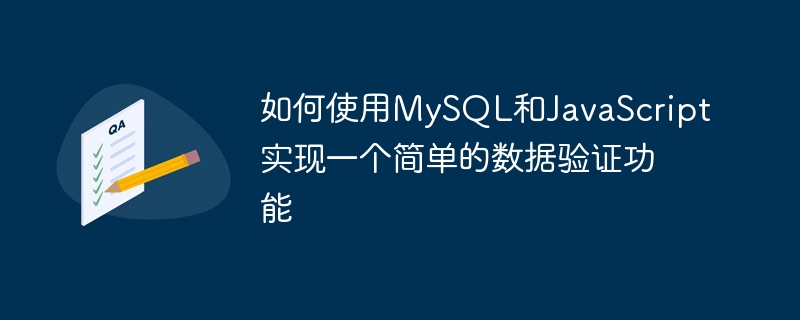Home >Database >Mysql Tutorial >How to implement a simple data validation function using MySQL and JavaScript
How to implement a simple data validation function using MySQL and JavaScript
- WBOYWBOYWBOYWBOYWBOYWBOYWBOYWBOYWBOYWBOYWBOYWBOYWBOriginal
- 2023-09-20 09:00:22975browse

How to use MySQL and JavaScript to implement a simple data validation function
In Web development, data validation is a very important and essential step. It can ensure that the data entered by users conforms to certain rules and formats, improves user experience, and also protects the integrity of the database. This article will introduce how to use MySQL and JavaScript to implement a simple data validation function, and provide specific code examples.
- Create data table
First, create a data table in MySQL to store user-submitted data. Suppose we create a data table named "users" that contains three fields: name, age, and email.
CREATE TABLE users (
id INT AUTO_INCREMENT PRIMARY KEY,
name VARCHAR(50) NOT NULL,
age INT NOT NULL,
email VARCHAR(100) NOT NULL
);- Create a front-end form
Next, create a form in the front-end page to collect user input information. Forms can be implemented using HTML and JavaScript. The following is a simple form example:
<form id="userForm">
<label for="nameInput">姓名:</label>
<input type="text" id="nameInput" required>
<label for="ageInput">年龄:</label>
<input type="number" id="ageInput" required>
<label for="emailInput">电子邮件:</label>
<input type="email" id="emailInput" required>
<button type="submit">提交</button>
</form>- Writing JavaScript code
Then, write code in JavaScript to implement the logic of data validation. We can use regular expressions to check whether the data entered by the user conforms to specific rules. The following is a simple sample code:
// 获取表单元素
const userForm = document.getElementById('userForm');
const nameInput = document.getElementById('nameInput');
const ageInput = document.getElementById('ageInput');
const emailInput = document.getElementById('emailInput');
// 表单提交事件处理函数
userForm.addEventListener('submit', function(event) {
event.preventDefault(); // 阻止表单默认提交行为
// 获取用户输入的数据
const name = nameInput.value;
const age = parseInt(ageInput.value);
const email = emailInput.value;
// 数据验证
if (!/^[A-Za-zs]+$/.test(name)) {
alert('姓名只能包含字母和空格!');
return;
}
if (age <= 0 || age > 150 || isNaN(age)) {
alert('年龄必须为介于1至150之间的数字!');
return;
}
if (!/^w+@w+.w+$/.test(email)) {
alert('电子邮件格式不正确!');
return;
}
// 数据提交到数据库
// 此处可以使用Ajax或其他方式将数据提交到后端进行处理,这里只做简单示范
// 假设有一个saveUser函数用于将数据保存到数据库
saveUser(name, age, email);
});
// 保存用户数据到数据库函数
function saveUser(name, age, email) {
// 发送Ajax请求或使用其他方法将数据保存到数据库
// 假设有一个saveUser.php文件用于保存数据
const data = {
name: name,
age: age,
email: email
};
// 发送Ajax请求
// ...
alert('数据保存成功!');
}- Backend data processing
Finally, we need to process the received data on the backend. Taking PHP as an example, you can write a simple interface file saveUser.php to save user data to the database. The following is a basic sample code:
<?php $name = $_POST['name']; $age = $_POST['age']; $email = $_POST['email']; // 进行数据验证 // ... // 将数据保存到数据库 // ... // 返回响应 $message = '数据保存成功!'; echo json_encode(['message' => $message]); ?>
So far, we have completed the steps of using MySQL and JavaScript to implement simple data validation functions, and provided specific code examples. In this way, we can ensure that the data submitted by users conforms to the required rules and formats, ensuring data integrity and accuracy. Of course, the actual situation may be more complicated, but this example can be used as a starting point for further expansion and optimization. Hope this article is helpful to you!
The above is the detailed content of How to implement a simple data validation function using MySQL and JavaScript. For more information, please follow other related articles on the PHP Chinese website!

